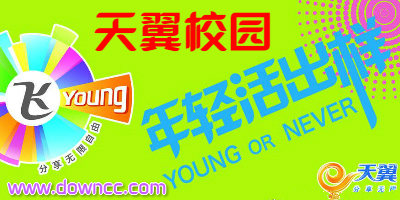
48.00M / 2022-02-22 / v1.3.1027 官方最新版
中国电信天翼飞young软件是电信为校园学生打造的一款综合套餐服务,在这里你可以进行电信的各类充值和积分兑换,校园购物、休闲娱乐等功能与提升,天翼“飞Young”提供了与众不同的特色应用,还有着游戏应用、便利购
9.34M / 2016-09-14 / v3.09 官方版
天翼飞young拨号器3.09是一款好用的校园上网客户端。为校园师生用户提供了便捷的上网套餐办理、宽带连接等功能。有不少网友们在搜索“天翼飞young3.09”版本,绿色资源网小编特地提供了这款旧版本下载地址。需要的用
10.14M / 2016-05-25 / v1.3 官方pc版
天翼校园客户端旧版本是江苏电信的一款宽带连接软件,这里之所以提供老版本给大家,是因为1.3版本具有wifi分享功能,让你可以使用无线热点,欢迎下载使用。 软件介绍“天翼校园客户端”是江苏电信为用户提供的宽带接
19.80M / 2015-03-15 / v5.3.0.1040 校园版专版驱动
天翼飞young有福了。根据测试,天翼飞young3.03校园版请使用以下的360WIFI驱动可以正常使用。记得安装玩驱动重启一下电脑哦。第一种方法:(适合天翼1.3.2客户端)a)先别插360随身wifi,等待电脑正常开机联网后b)请
8.23M / 2016-09-08 / v2.2.6 官网版
安徽天翼校园客户端是是安徽电信宽带校园用户打造的一款上网拨号应用。用户可以使用这款软件快速登陆电信校园宽带账号,可以一键绑定电信账号,提供免登陆功能。通过内网,你可以在线观看高清电影、在线玩游戏、下载
8.23M / 2016-09-08 / v2.2.6 官网最新版
四川天翼校园客户端是一款为四川学子打造的电信宽带连接工具,软件功能强大,更有多种功能供你使用,如游戏中心、天翼校园、休闲娱乐、便利购物、应用中心等等,全方位为你打造愉快的校园上网服务。官方简介:天翼飞
8.23M / 2016-09-08 / v2.2.6 官网版
湖北天翼校园客户端是湖北电信专为湖北各大校园电信宽带连接所准备的一款拨号软件,为用户提供稳定。便捷的拨号上网功能的同时,集生活、学习、社交于一体,还在等什么,快来绿色资源网下载吧。 应用简介:天翼校园
22.90M / 2021-11-16 / v5.2.0 官方安卓版
广东天翼校园网手机客户端是中国电信天翼专为广大校园学生打造的宽度app,用手机就可以进行宽度拨号,还可以用wifi登录;欠费了吗?手机充值缴费更方便,校园学生用户必备!官方介绍广东校园:为学生打造的校园宽带连
979KB / 2018-05-08 / v1.1 安卓版
天翼飞young安卓平板app是由中国电信官方推出的一款校园上网客户端。学子们可以使用本软件进行宽带连接,轻松拨号!支持安卓平板设备操作使用!并且推出了手机续费、上网费用查询,上网账号、密码设置服务。欢迎大家
20.79M / 2019-08-12 / v0.9.3 安卓版
连点猜谜是一款非常好玩休闲的连线游戏,游戏中画面非常的简约,并且还有着非常多的霓虹色彩看着非常的治愈,你将在这款游戏中体验到各种梦幻治愈的连线色彩图案,操作起来也是相当的简单,只需要看准数字然后连线就
729KB / 2021-11-15 / v1.1.0 安卓版
校园无线盒子app即wifi盒子,是由中国电信专为校园学生们打造的移动wifi盒子。用户安装wifi盒子后,在校内即可随时随地上网,绝对是校园生活必备神器!赶快下载体验吧!电信集团简介中国电信集团公司是我国特大型国有
15.08M / 2015-03-20 / V4.0.5 安卓版
天翼校园云是一款为在校学生的学习、生活和娱乐提供便捷的无线信息化服务,提升学生生活的无线化水平,致力于为全体师生提供随时随地所需的学习、生活、社交等服务的服务平台软件。赶快下载尝试吧!!功能特点1、通过
4.78M / 2015-11-16 / v1.3 苹果电脑版
天翼校园客户端for mac是MAC OS平台上使用的校园拨号工具,苹果电脑用户下载后可方便的登录校园网,操作也很简单,同时它还提供了邮件提醒、个性换肤、无线网络连接等多种实用的功能,为在校学生的学习、生活、娱乐提